EBOOKS ABOUT WOMEN
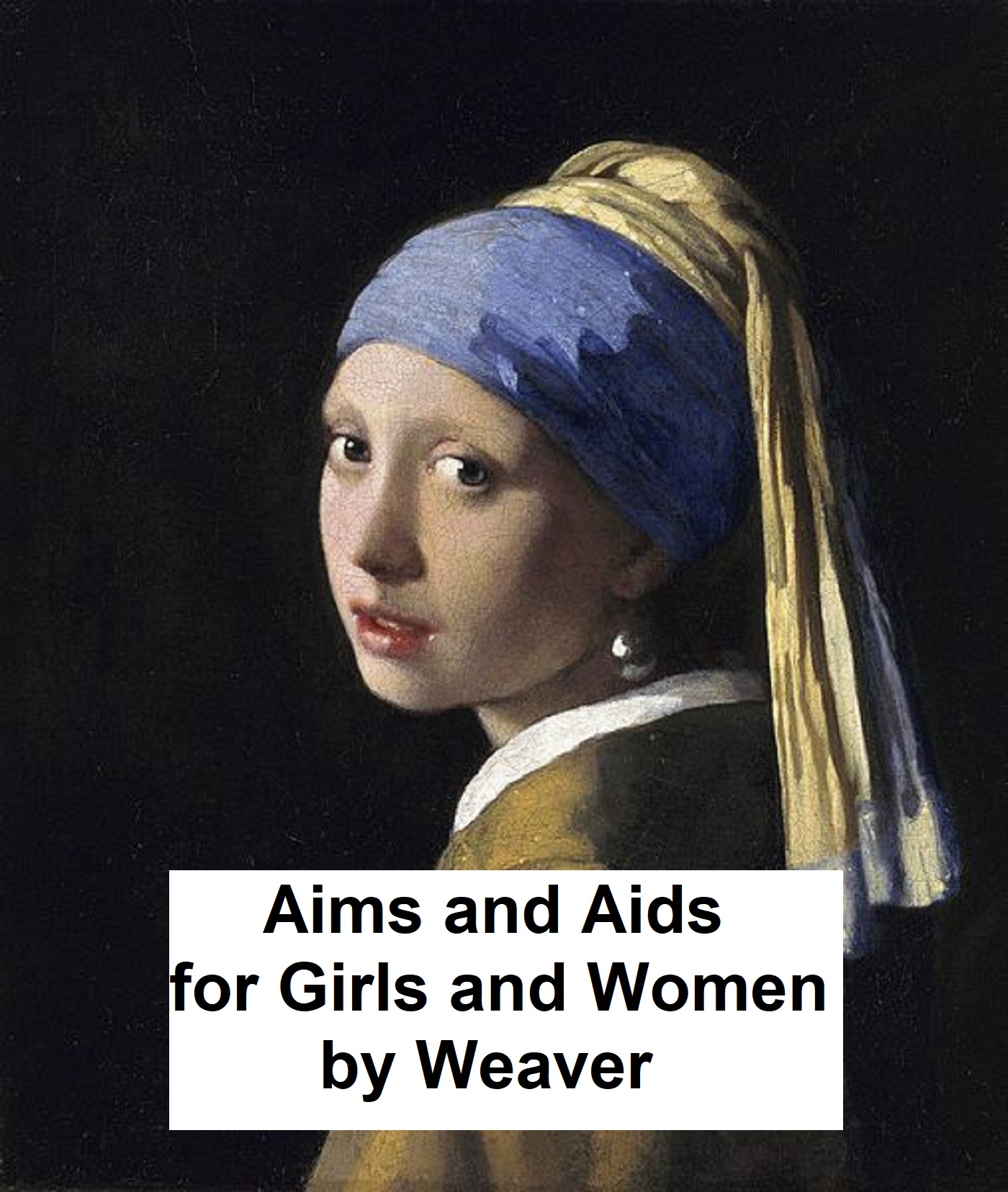 Aims and Aids for Girls and Women on the
Various Duties of Life by G. S. Weaver
Aims and Aids for Girls and Women on the
Various Duties of Life by G. S. WeaverAdvice, first published in 1856. "My interest in woman and our common humanity is my only apology for writing this book. I see multitudes of young women about me, whose general training is so deficient in all that pertains to the best ideas of life, and whose aims and efforts are so unworthy of their powers of mind and heart, that I can not make peace with my own conscience without doing something to elevate their aims and quicken their aspirations for the good and pure in thought and life. Our female schools are but poor apologies for the purposes of mind-culture and soul-development..."
99 cents at Kobo
99 cents at Nook (Barnes and Noble)
 The
Business of Being a Woman by Ida Tarbell
The
Business of Being a Woman by Ida TarbellFirst published in 1921. "The object of this little volume is to call attention to a certain distrust, which the author feels in the modern woman, of the significance and dignity of the work laid upon her by Nature and by society. Its ideas are the result of a long, if somewhat desultory, observation of the professional, political, and domestic activities of women in this country and in France. These observations have led to certain definite opinions as to those phases of the woman question most in need of emphasis to-day." According to Wikipedia: "Ida Minerva Tarbell (November 5, 1857 – January 6, 1944) was an American teacher, author and journalist. She was one of the leading "muckrakers" of the progressive era. She wrote many notable magazine series and biographies. She is best known for her 1904 book The History of the Standard Oil Company, which was listed as No. 5 in a 1999 list by New York University of the top 100 works of 20th-century American journalism. She depicted John D. Rockefeller as crabbed, miserly, money-grabbing, and viciously effective at monopolizing the oil trade."
99 cents at Kobo
99 cents at Nook (Barnes and Noble)
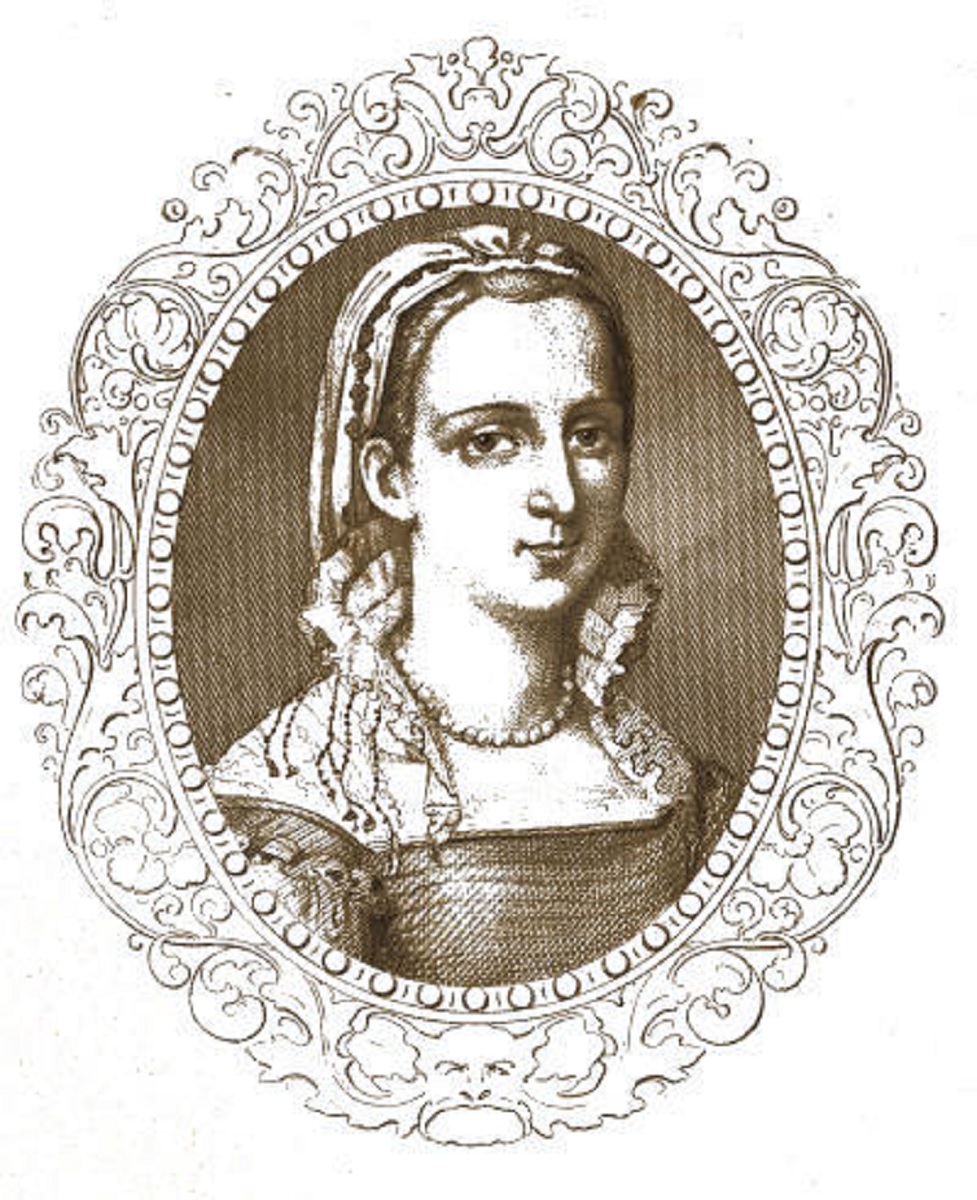 A Decade of
Italian Women, Illustrated, by T. Adolphus Trollope
A Decade of
Italian Women, Illustrated, by T. Adolphus TrollopeFirst published in 1859. Biographies of ten Italian women -- Saint Catherine of Siena, Caterina Sforza, Vittoria Colonna, Tullia D'Aragona, Olympia Morata, Isabella Andreini, Bianca Cappello, Olympia Pamfili, Elisabetta Sirani, and La Corilla.
99 cents at Kobo
99 cents at Nook (Barnes and Noble)
 The Eugenic
Marriage, a personal guide to the new science of better living
and better babies, all four volumes, by W. Grant Hague
The Eugenic
Marriage, a personal guide to the new science of better living
and better babies, all four volumes, by W. Grant Hague First published in 1914. All four volumes in a single file. Do not rely on this book for medical. Rather you should use it historically, as an indication of what was known and believed at time it was written. "Despite the fact that much has been written during the past two or three years with reference to Eugenics, it is quite evident to any one interested in the subject that the average intelligent individual knows very little about it so far as its scope and intent are concerned. This is not to be wondered at, for the subject has not been presented to the ordinary reader in a form that would tend to encourage inquiry or honest investigation. The critic and the wit have deliberately misinterpreted its principles, and have almost succeeded in masking its supreme function in the garb of folly."
99 cents at Kobo
99 cents at Nook (Barnes and Noble)
 The Good Housekeeping Marriage Book, twelve steps
to a happy marriage, edited by William F. Bigelow
The Good Housekeeping Marriage Book, twelve steps
to a happy marriage, edited by William F. Bigelow"The articles that are printed in this book made what was in my opinion the most important, the most constructive, series on a single subject that Good Housekeeping has published in the quarter century and more that I was its editor. And they might so easily never have been written--just a little item in a newspaper missed, or its significance overlooked, and these sincere and helpful articles would still be locked up in the minds and hearts of the men and women who wrote them. For it all happened just like that. Students in one of the larger California universities asked that a course in marriage relations be given--and a New York newspaper heralded it with a stick of type over about page 10..."
99 cents at Kobo
99 cents at Nook (Barnes and Noble)
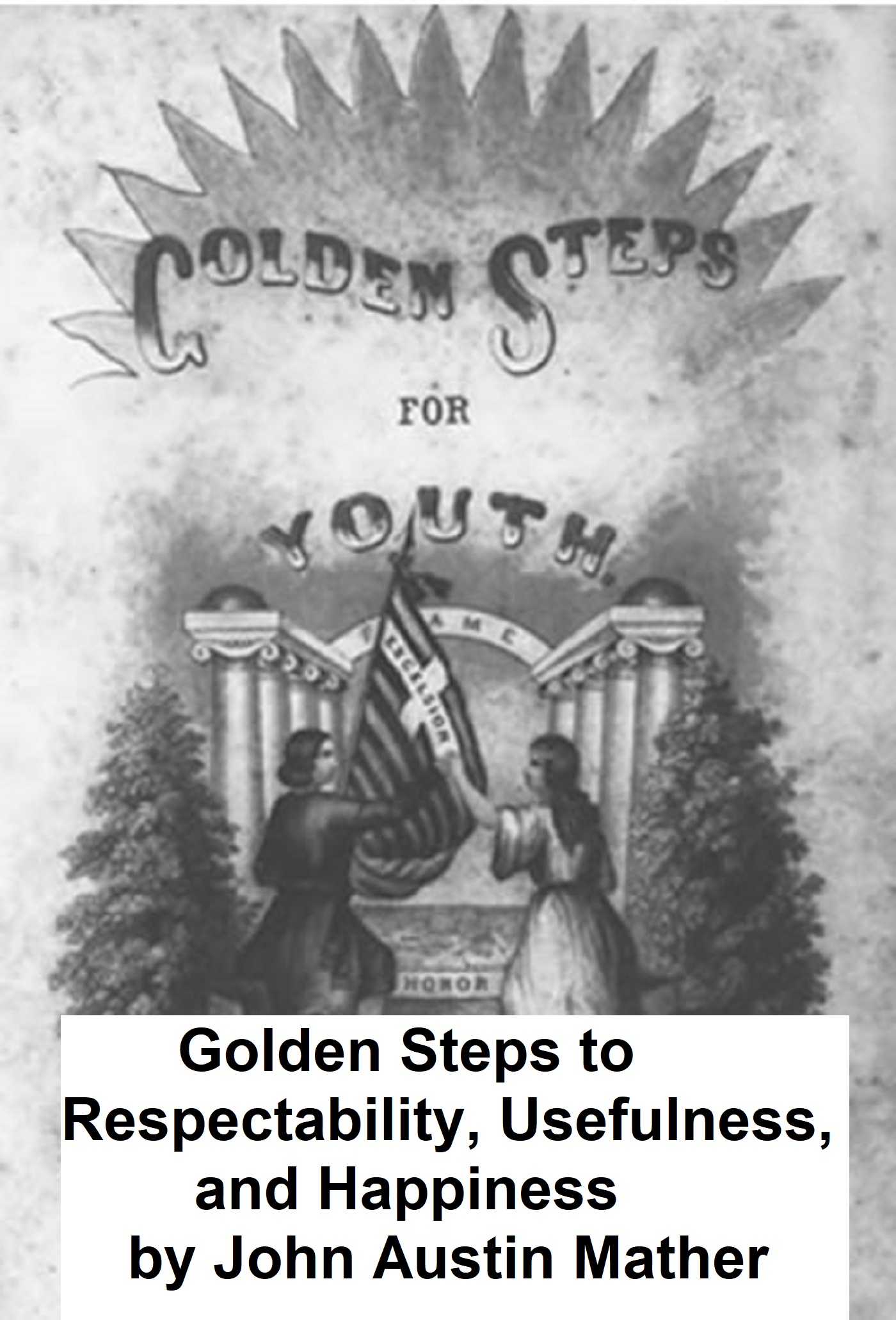 Golden Steps to Respectability, Usefulness,
and Happiness , being a series of lectures to youth of both
sexes on character, principles, associates, amusements,
religion, and marriage by John Mather Austin
Golden Steps to Respectability, Usefulness,
and Happiness , being a series of lectures to youth of both
sexes on character, principles, associates, amusements,
religion, and marriage by John Mather AustinAdvice, first published in 1851. "The Lectures embraced in this volume, were written for the pulpit, in the usual manner of preparation for such labor, without any expectation of their appearing in print. The author is but too sensible that they are imperfect in many features, both in matter and style. It is only in the hope that they will be of some benefit to the class to whom they are addressed, that he has consented to submit them to public perusal. He has aimed at nothing eccentric, odd, or far-fetched; but has sought to utter plain and obvious truths, in a plain and simple manner. There is no class more interesting, and none which has higher claims on the wisdom, experience, and advice, of mature minds, than the young who are about to enter upon the trying duties and responsibilities of active life..."
99 cents at Kobo
99 cents at Nook (Barnes and Noble)
 Modern Marriage and How to Bear It by Maud
Churton Braby, $1.99
Modern Marriage and How to Bear It by Maud
Churton Braby, $1.99 
Practical and humorous advice, first published around 1900. The first few chapters are entitled: The Mutual Dissatisfaction of the Sexes, Why Men Don't Marry, Why Women Don't Marry, and The Tragedy of the Undesired.
99 cents at Kobo
99 cents at Nook (Barnes and Noble)
 History of Woman Suffrage, all six volumes,
edited by Elizabeth Cady Stanton, Susan B. Anthony, and Matilda
Joslyn Gage, $2.99
History of Woman Suffrage, all six volumes,
edited by Elizabeth Cady Stanton, Susan B. Anthony, and Matilda
Joslyn Gage, $2.99 
This file includes all six volumes, told by the heroines who fought for the women's vote. . According to the Preface, this book is "Woven with the threads of this (Woman's suffrage) history, we have given some personal reminiscences and brief biographical sketches." According to Wikipedia, "Elizabeth Cady Stanton (November 12, 1815 – October 26, 1902) was an American social activist, abolitionist, and leading figure of the early woman's movement. Her Declaration of Sentiments, presented at the first women's rights convention held in 1848 in Seneca Falls, New York, is often credited with initiating the first organized woman's rights and woman's suffrage movements in the United States. Susan Brownell Anthony (February 15, 1820 – March 13, 1906) was a prominent American civil rights leader who played a pivotal role in the 19th century women's rights movement to introduce women's suffrage into the United States. She traveled the United States, and Europe, and averaged 75 to 100 speeches per year. Matilda Electa Joslyn Gage (Cicero, New York, March 24, 1826 – March 18, 1898 in Chicago) was a suffragist, a Native American activist, an abolitionist, a freethinker, and a prolific author, who was "born with a hatred of oppression. Ida Husted Harper (February 18, 1851 – March 14, 1931) was a prominent figure in the United States women's suffrage movement. She was an American author and journalist who wrote primarily to document the movement and show support of its ideals."
99 cents at Kobo
99 cents at Nook (Barnes and Noble)
 The
Suffrage Cook Book, Illustrated, compiled by Mrs. L. O. Kleber
The
Suffrage Cook Book, Illustrated, compiled by Mrs. L. O. KleberFirst published in 1915, with hundreds of recipes contributed by supporters of the suffrage movement (seeking the right to vote for women), and links to every recipe. "There are cook books and cook books, and their generation is not ended; a generation that began in the Garden of Eden, presumably, for if Mother Eve was not vastly different from her daughters she knew how to cook some things better than her neighbors, and they wanted to know how she made them and she wanted to tell them..."
99 cents at Kobo
99 cents at Nook (Barnes and Noble)
 A Vindication of the Rights of Women, With
Strictures on Political and Moral Subjects by Mary
Wollstonecraft
A Vindication of the Rights of Women, With
Strictures on Political and Moral Subjects by Mary
WollstonecraftSeminal work on the rights of woman. According to Wikipedia: "A Vindication of the Rights of Woman: with Strictures on Political and Moral Subjects (1792), written by the 18th-century British feminist Mary Wollstonecraft, is one of the earliest works of feminist philosophy. In it, Wollstonecraft responds to those educational and political theorists of the 18th century who did not believe women should have an education. She argues that women ought to have an education commensurate with their position in society, claiming that women are essential to the nation because they educate its children and because they could be "companions" to their husbands, rather than mere wives. Instead of viewing women as ornaments to society or property to be traded in marriage, Wollstonecraft maintains that they are human beings deserving of the same fundamental rights as men. Wollstonecraft was prompted to write the Rights of Woman after reading Charles Maurice de Talleyrand-Périgord's 1791 report to the French National Assembly, which stated that women should only receive a domestic education; she used her commentary on this specific event to launch a broad attack against sexual double standards and to indict men for encouraging women to indulge in excessive emotion. Wollstonecraft wrote the Rights of Woman hurriedly in order to respond directly to ongoing events; she intended to write a more thoughtful second volume but died before completing it."
99 cents at Kobo
99 cents at Nook (Barnes and Noble)
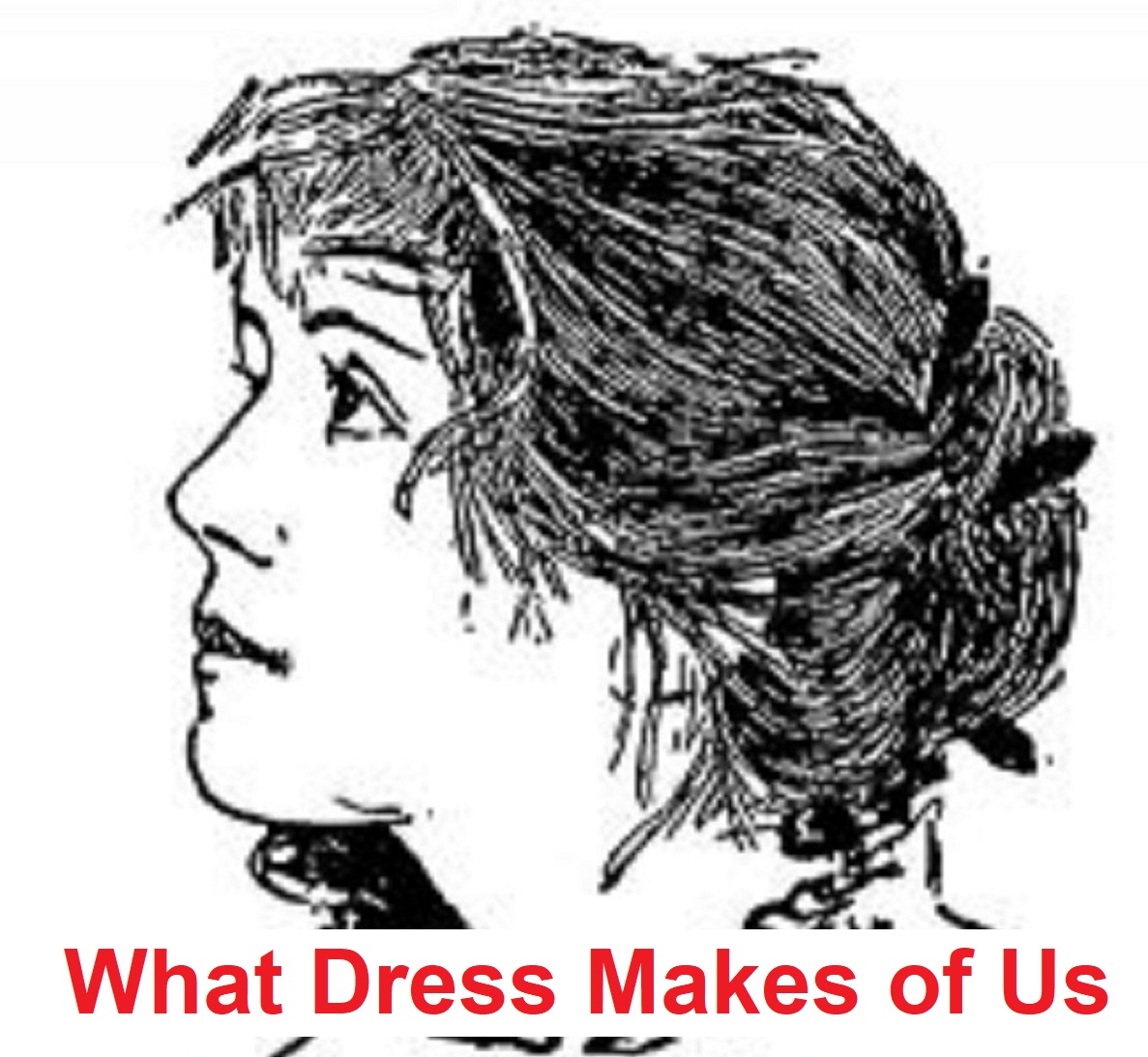 What Dress Makes of Us, Illustrated, by Dorothy
Quigley,
What Dress Makes of Us, Illustrated, by Dorothy
Quigley,Practical clothing advice for women, first published in 1897. "Did you ever observe, dear comrade, what an element of caricature lurks in clothes? A short, round coat on a stout man seems to exaggerate his proportions to such a ridiculous degree that the profile of his manly form suggests "the robust bulge of an old jug." A bonnet decorated with loops of ribbon and sprays of grass, or flowers that fall aslant, may give a laughably tipsy air to the long face of a saintly matron of pious and conservative habits. A peaked hat and tight-fitting, long-skirted coat may so magnify the meagre physical endowments of a tall, slender girl that she attains the lank and longish look of a bottle of hock."
99 cents at Kobo
99 cents at Nook (Barnes and Noble)
 What a Young Woman Ought to Know by Mrs.
Mary Wood-Allen
What a Young Woman Ought to Know by Mrs.
Mary Wood-AllenFirst published in 1913. Part of the Self and Sex Series. According to the Preface: "During a number of years it has been my privilege to be the confidante and counsellor of a large number of young women of various stations in life and in all parts of the United States. These girls have talked freely with me concerning their plans, aspirations, fears and personal problems. It has been a great revelation to me to note with what unanimity they ask certain questions concerning conduct--queries which perhaps might astonish the mothers of those same girls, as they, doubtless, take it for granted that their daughters intuitively understand these fundamental laws of propriety. The truth is that many girls who have been taught in the "ologies" of the schools, who have been trained in the conventionalities of society, have been left to pick up as they may their ideas upon personal conduct, and, coming face to face with puzzling problems, are at a loss, and perhaps are led into wrong ways of thinking and questionable ways of doing because no one has foreseen their dilemma and warned them how to meet it."
99 cents at Kobo
99 cents at Nook (Barnes and Noble)
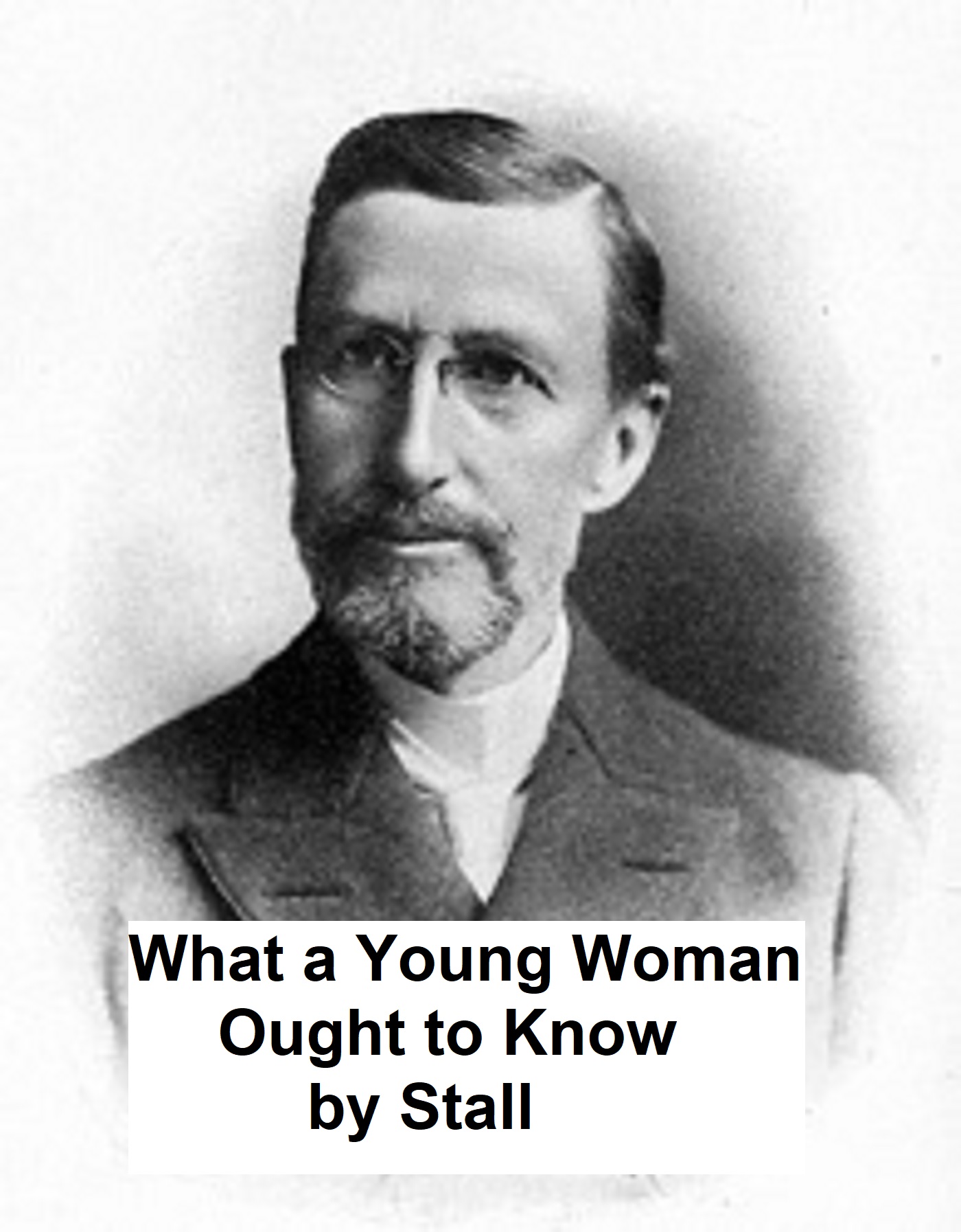 What a Young Husband Ought to Know by Sylvanus
Stall
What a Young Husband Ought to Know by Sylvanus
StallPractical advice on marital relations and sex, first published in 1897. The Preface explains: "In approaching the work which we have undertaken in these pages, we have not been blind to the difficulties which confront us in entering upon so delicate a subject. If we had thought only of these, we would never have taken up our pen in this work. We have been moved to it by the cries of disappointment and anguish which may be heard everywhere throughout our land, and by the pleadings that come up out of the dense ignorance which envelops palace and hovel alike. Knowing the importance of these "matters which are so central in our physical life, so essential in their relation to the condition, character, career and destiny of every individual, and so fundamental and vital to every institution and interest of society;" knowing also the importance of proper intelligence concerning the laws which govern our bodies, and knowing how the honest and the pure who seek information concerning these most sacred relations of human life are exposed, amid the dearth of pure and reliable books, to contamination by books whose secret character designedly fosters the very lusts and evils which they are professedly written to denounce, we have felt that we would be recreant to duty, to humanity and to God if we allowed difficulties to bar us from this important work."
99 cents at Kobo
99 cents at Nook (Barnes and Noble)
 Woman as
Decoration, Illustrated, by Emily Burband
Woman as
Decoration, Illustrated, by Emily BurbandFirst published in 1917, advice which was seriously meant at the time it was written can now be read as humor. As explained in the Foreword: "WOMAN AS DECORATION is intended as a sequel to "The Art of Interior Decoration" (Grace Wood and Emily Burbank). Having assisted in setting the stage for woman, the next logical step is the consideration of woman, herself, as an important factor in the decorative scheme of any setting,--the vital spark to animate all interior decoration, private or public. The book in hand is intended as a brief guide for the woman who would understand her own type,--make the most of it, and know how simple a matter it is to be decorative if she will but master the few rules underlying all successful dressing. As the costuming of woman is an art, the history of that art must be known--to a certain extent--by one who would be an intelligent student of our subject. With the assistance of thirty-three illustrations to throw light upon the text, we have tried to tell the beguiling story of decorative woman, as she appears in frescoes and bas reliefs of Ancient Egypt, on Greek vases, the Gothic woman in tapestry and stained glass, woman in painting, stucco and tapestry of the Renaissance, seventeenth, eighteenth and nineteenth century woman in portraits."
99 cents at Kobo
99 cents at Nook (Barnes and Noble)
 Women as
Sex Vendors or Why Women Are Conservative (Being a View of the
Economic Status of Women) by R. B. Tobias
Women as
Sex Vendors or Why Women Are Conservative (Being a View of the
Economic Status of Women) by R. B. TobiasFirst published in 1918. The book begins: "We have often heard discussions of the reason we do not find women, as a sex, in the vanguard of world affairs; why the great educators, strong figures in progressive or revolutionary movements, are men rather than women; why these movements, themselves, are made up almost entirely of men rather than women. People have asked over and over again why, in the fields of the arts, the sciences, in the world of "practical affairs," men, rather than women, generally excel."
99 cents at Kobo
99 cents at Nook (Barnes and Noble)
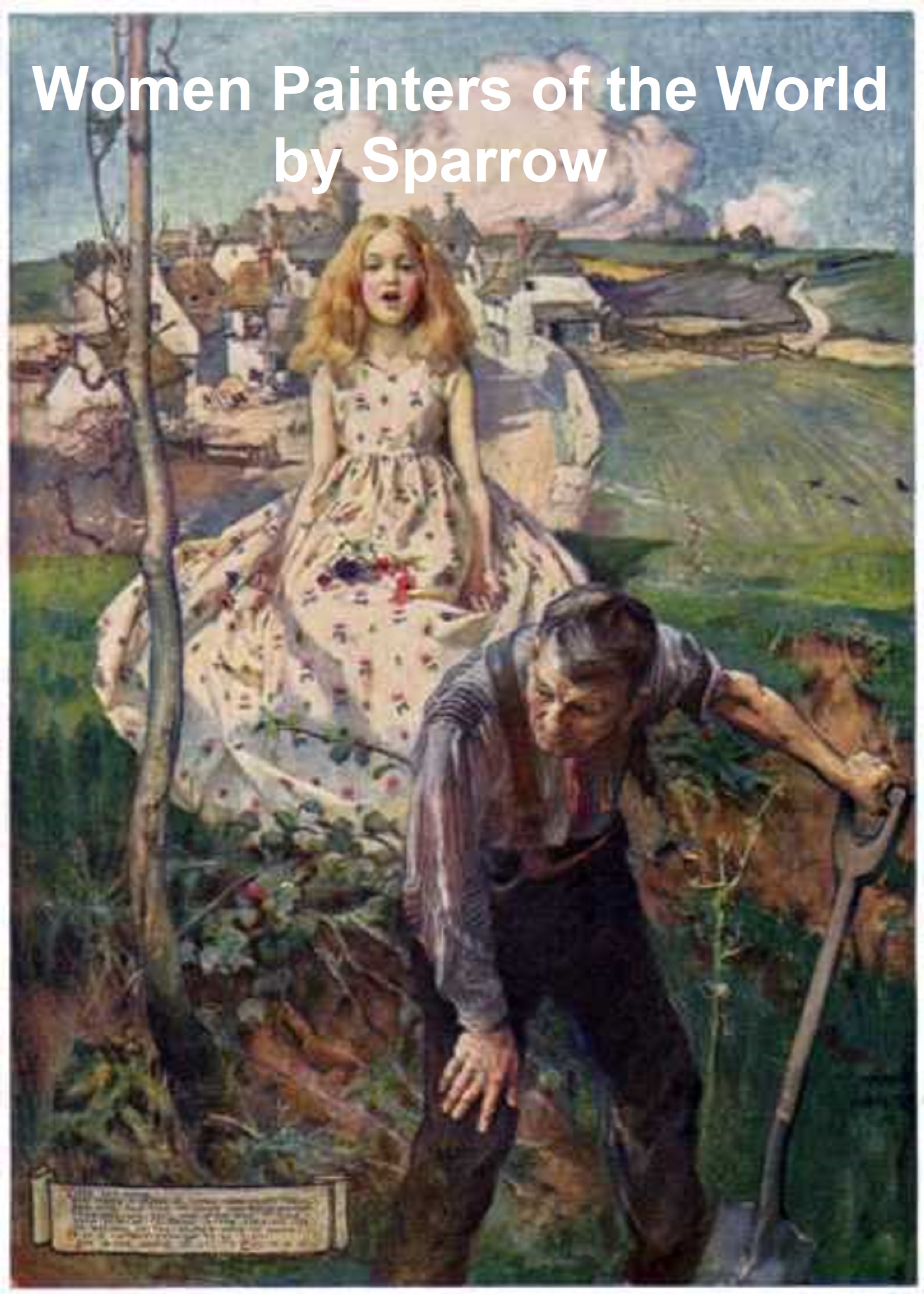 Women Painters of the World, from
the Time of Caterina Vigri (1413-1463) to Rosa Bonheur and the
Present Day. Illustrated, Edited by Walter Shaw Sparrow
Women Painters of the World, from
the Time of Caterina Vigri (1413-1463) to Rosa Bonheur and the
Present Day. Illustrated, Edited by Walter Shaw Sparrow
With hundreds of illustrations. First published in
1905. According to the Preface: " HAT is genius? Is
it not both masculine and feminine? Are not some of its
qualities instinct with manhood, while others delight us with
the most winning graces of a perfect womanhood? Does not genius
make its appeal as a single creative agent with a two-fold sex?
But if genius has its Mirandas and its Regans no less than its
infinite types of men, ranging from Prospero and Ferdinand to
Caliban and Trinculo, its union of the sexes does not remain
always at peace within the sphere of art. Sometimes, in the
genius of men, the female characteristics gain mastery over the
male qualities; at other times the male attributes of woman's
genius win empire and precedence over the female; and whenever
these things happen, the works produced in art soon recede from
the world's sympathies, losing all their first freshness."
99
cents at Kobo
99
cents at Nook (Barnes and Noble)
 Roman Women, Illustrated, by Alfred
Brittain
Roman Women, Illustrated, by Alfred
Brittain
Volume 2 of Woman in All Ages and in All Countries. First
published in 1907. According to the Preface: "The student of
history does not proceed far in his researches before he
discovers that human nature is a fixed quality. Other lands,
other manners; other times, other customs. But the man behind
the manner is essentially the same; the woman under the changed
custom is not thereby rendered essentially different, any more
than she is by a varying of costume. The women of ancient Rome
exemplified the same virtues, and were impelled by the same
foibles as are the women of to-day. And the difference in
environment, the vanished conditions of Roman life, gain large
scientific interest from the fact that they did not result in
any dissimilarity of fundamental character. If, by the most
violent exercise of the imagination, it were possible to
transport a female infant of the twentieth century, and cause
her to be reared among the women of the Augustan age, she would
fit as naturally into her surroundings as she would into the
present society of London or of New York."
99
cents at Kobo
99
cents at Nook (Barnes and Noble)
 Oriental Women, Illustrated, by
Edward PollardVolume 4 of Woman in All Ages and in All
Countries. First published in 1907. According to the
Preface: "The relative position which woman occupies in any
country is an index to the civilization which that country
enjoys, and this test applied to the Orient reveals many stages
yet to be achieved. The frequent appearance of woman in Holy
Writ is sufficient evidence of the high position accorded her in
the Hebrew nation. Such characters as Ruth, Esther, and Rebekah
have become famous. Wicked women there were, such as Jezebel,
but happily their influence was not of lasting duration."
Oriental Women, Illustrated, by
Edward PollardVolume 4 of Woman in All Ages and in All
Countries. First published in 1907. According to the
Preface: "The relative position which woman occupies in any
country is an index to the civilization which that country
enjoys, and this test applied to the Orient reveals many stages
yet to be achieved. The frequent appearance of woman in Holy
Writ is sufficient evidence of the high position accorded her in
the Hebrew nation. Such characters as Ruth, Esther, and Rebekah
have become famous. Wicked women there were, such as Jezebel,
but happily their influence was not of lasting duration."
99
cents at Kobo
99
cents at Nook (Barnes and Noble)
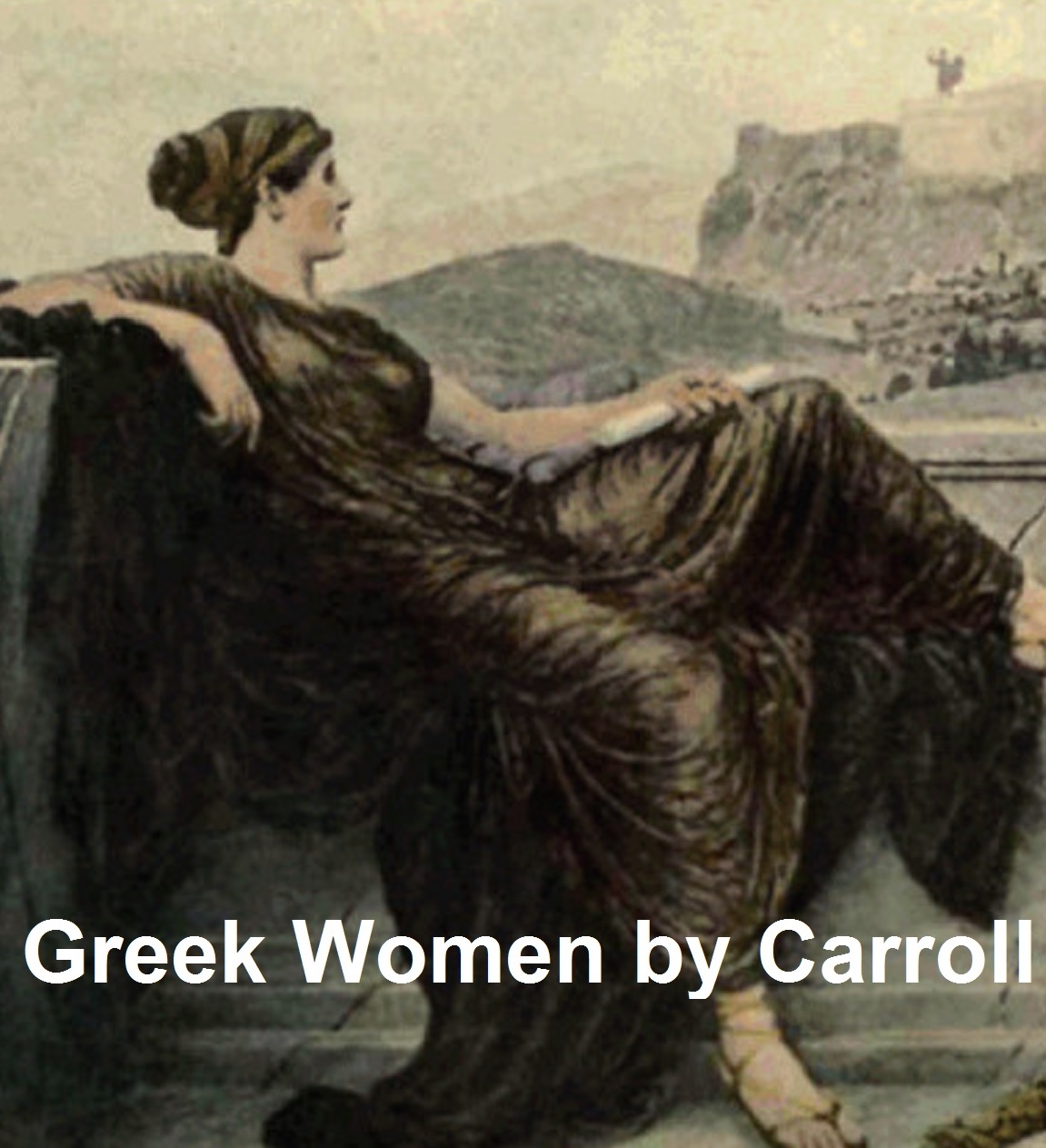 Greek Women, Illustrated, by
Mitchell Carroll
Greek Women, Illustrated, by
Mitchell Carroll
Volume 1 of Woman in All Ages and in All Countries. First
published in 1907. The author was Professor of Classical
Philology at George Washington University. According to
the Preface: "It is the purpose of this volume to give a simple
sketch of the history of Greek womanhood from the Heroic Age
down to Roman times, so far as it can be gathered from ancient
Greek literature and from other available sources for a
knowledge of antique life. Greek civilization was essentially a
masculine one; and it is really remarkable how scant are the
references to feminine life in Greek writers, and how few books
have been written by modern scholars on this subject."
99
cents at Kobo
99
cents at Nook (Barnes and Noble)
 Women of Early Christianity,
Illustrated, by Alfred Brittain
Women of Early Christianity,
Illustrated, by Alfred Brittain
First published in 1907. According to the Preface:
"Christianity introduced a new moral epoch in the course of
human history. Its effect was necessarily transforming upon
those who came under its sway. Being cosmopolitan in its nature,
we have now to study woman as being somewhat dissociated from
racial type and national manner, and we shall seek to ascertain
how she met and was modified by Christian conditions. These had
a larger effect upon her life than upon that of man; for, by its
nature, Christianity gave an opening for the higher
possibilities of her being of which the old religions took
little account. In the realm of the spiritual, it, for the first
time, assented to her equality with man. That the women of the
first Christian centuries submitted themselves to the influence
of that religion in a varying degree, the following pages will
abundantly show."
99
cents at Kobo
99
cents at Nook (Barnes and Noble)
 Women of Medieval France,
Illustrated, by Pierce Butler
Women of Medieval France,
Illustrated, by Pierce Butler
First published in 1907. According to the Preface: "From the
mediaeval Ladies' Book, of a kind that will be referred to in
the following pages, to the very latest volume of Social
England, or more aptly, perhaps, to the most local and frivolous
Woman's World edited by an Eve in your daily paper, all the
little repositories of ebbing gossip help immensely in the
composition of a picture of the life of any period. They are not
history; by the dignified historian of a few generations ago
they were neglected if not scorned; but more and more are they
coming to their own as material for history. In like manner the
volume hardly claims to be a formal history, but rather
ancillary to history. It has been the aim to present pictures
from history, scenes from the lives of historic women, but above
and through all to give as definite an idea as might be of the
life of women at various periods in the history of mediaeval
France."
99
cents at Kobo
99
cents at Nook (Barnes and Noble)
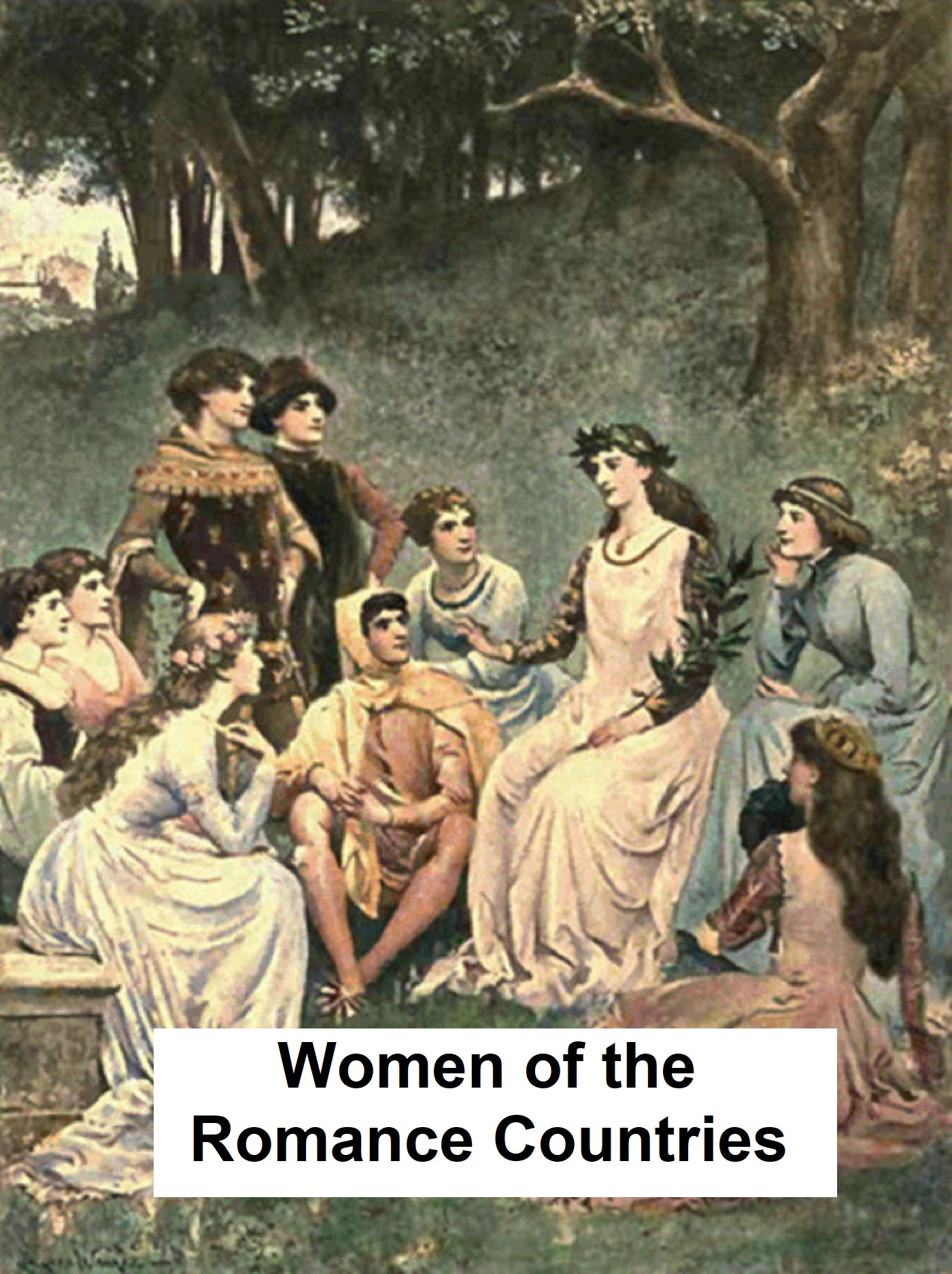 Women of the Romance Countries,
Illustrated, by John R. Effinger
Women of the Romance Countries,
Illustrated, by John R. Effinger
First published in 1907. According to the Preface: "What,
then, must have been the task of the author of the present
volume, in essaying to write of the women of Italy and Spain! In
neither of these countries are the people all of the same race,
nor do they afford the development of a constant type for
observation or study. Italy, with its medićval chaos, its free
cities, and its fast-and-loose allegiance to the temporal power
of the Eternal City, has ever been the despair of the orderly
historian; and Spain, overrun by Goth, by Roman, and by Moslem
host, presents strange contrasts and rare complexities. Such
being the case, this account of the women of the Romance
countries does not attempt to trace in detail their gradual
evolution, but rather to present, in the proper setting, the
most conspicuous examples of their good or evil influence, their
bravery or their cowardice, their loyalty or their infidelity,
their learning or their illiteracy, their intelligence or their
ignorance, throughout the succeeding years."
99
cents at Kobo
99
cents at Nook (Barnes and Noble)
 Women of Modern France,
Illustrated, by Hugo Thieme
Women of Modern France,
Illustrated, by Hugo Thieme
First published in 1907. According to the Preface: "Among
the Latin races, the French race differs essentially in one
characteristic which has been the key to the success of French
women--namely, the social instinct. The whole French nation has
always lived for the present time, in actuality, deriving from
life more of what may be called social pleasure than any other
nation. It has been a universal characteristic among French
people since the sixteenth century to love to please, to make
themselves agreeable, to bring joy and happiness to others, and
to be loved and admired as well. With this instinctive trait
French women have always been bountifully endowed. Highly
emotional, they love to charm, and this has become an art with
them; balancing this emotional nature is the mathematical
quality. These two combined have made French women the great
leaders in their own country and among women of all races."
99
cents at Kobo
99
cents at Nook (Barnes and Noble)
 Women of the Teutonic Nations,
Illustrated, by Hermann Schoenfeld
Women of the Teutonic Nations,
Illustrated, by Hermann Schoenfeld
Volume 8 of Woman in All Ages and in All Countries. First
published in 1907. According to the Preface: "Our limited
task is merely to deal succinctly with the most general
evolution of the social position and the cultural status of the
Teutonic and, even more briefly, of the Slavic woman at the
various epochs of their respective histories, and how far the
history of civilization among those races was influenced by
them, how far the symptoms of national morality and the degree
of culture were shaped by feminine achievements, proclivities,
virtues, and vices. Two thousand years of the richest, almost
unfathomable, history had to be traversed in the attempt to
glean the essential red thread from the enormous masses of facts
which in their entirety would be inaccessible even to the most
universal historical scholar. Most difficult of all the periods
is perhaps the question of the present and actual women's
movement, which is now in its liveliest flux and in a most
variable condition both in the German and in the Slavic world. "
99
cents at Kobo
99
cents at Nook (Barnes and Noble)
 Women of England, Illustrated, by
Barlett Burleigh James
Women of England, Illustrated, by
Barlett Burleigh James
First published in 1907. According to the Preface: "It is
no slight task to follow out the windings of a single thread in
the infinite weave of society and by loosing it from the general
mesh to show how dependent is the pattern of life and custom
upon its presence. Such a task was presented in the endeavor to
trace along from remotest times to the present day the influence
of woman upon the life and character, the efforts and ideals, of
that race which has come to be known as English, although this
name may not properly be used until time has spun into the vista
of the past peoples as vigorous, if not influential, as the one
that stands, the inheritor of their virility, at the apex of
modern civilization, whose women, clasping hands throughout the
British Empire, form a splendid chain of hope for womankind in
all the world."
99
cents at Kobo
99
cents at Nook (Barnes and Noble)
 Women of America, Illustrated, by
John Rouse Larus
Women of America, Illustrated, by
John Rouse Larus
First published in 1907. According to the Introduction:
"Of the North American aboriginal woman the knowledge possessed
admits of but broad generalities as to her status and condition.
The author of this volume has, however, happily extracted from
the available sources what is informing as to the position of
the woman so that a better conception of her will be the part of
his readers. It will be seen that she has not always been the
neglected and unconsidered creature that the popular mind has
accepted. Instead, she has held among many tribes a higher place
of power than man, and that by custom and in fact she was held
in high consideration. The condition of the aboriginal woman
before the advent of the white race was not that to which she
fell as the consequence of that advent."
99
cents at Kobo
99
cents at Nook (Barnes and Noble)
 The Wit of Women by Kate Sanborn
The Wit of Women by Kate Sanborn
Humor collection first published in 1885. According to
Wikipedia: "Katherine Abbott Sanborn (11 July 1839 - 9 July
1917) was an American author, teacher and lecturer. She was born
in Hanover, New Hampshire, the daughter of educator Edwin David
Sanborn and his wife Mary Ann. She taught English literature in
several places, and was a professor at Smith College in that
subject for several years, resigning in 1886 in order to follow
literary pursuits in New York City. She lectured in public on
literary history and allied subjects, and wrote on education.
Her lecturing career began in the drawing room of her friend
Anne Lynch Botta and later she gave talks for clubs and schools
on current literature. For several years she was a newspaper
correspondent in New York City. She also edited calendars and
holiday books."
99
cents at Kobo
99
cents at Nook (Barnes and Noble)
 In Defense
of Women by H. L. Mencken
In Defense
of Women by H. L. MenckenClassic collection of satirical essays, including The Feminine Mind, The War Between the Sexes, Marriage, Woman Sufrage, and The New Age. The Introduction begins: "As a professional critic of life and letters, my principal business in the world is that of manufacturing platitudes for tomorrow, which is to say, ideas so novel that they will be instantly rejected as insane and outrageous by all right thinking men, and so apposite and sound that they will eventually conquer that instinctive opposition, and force themselves into the traditional wisdom of the race."
99 cents at Kobo
99 cents at Nook (Barnes and Noble)
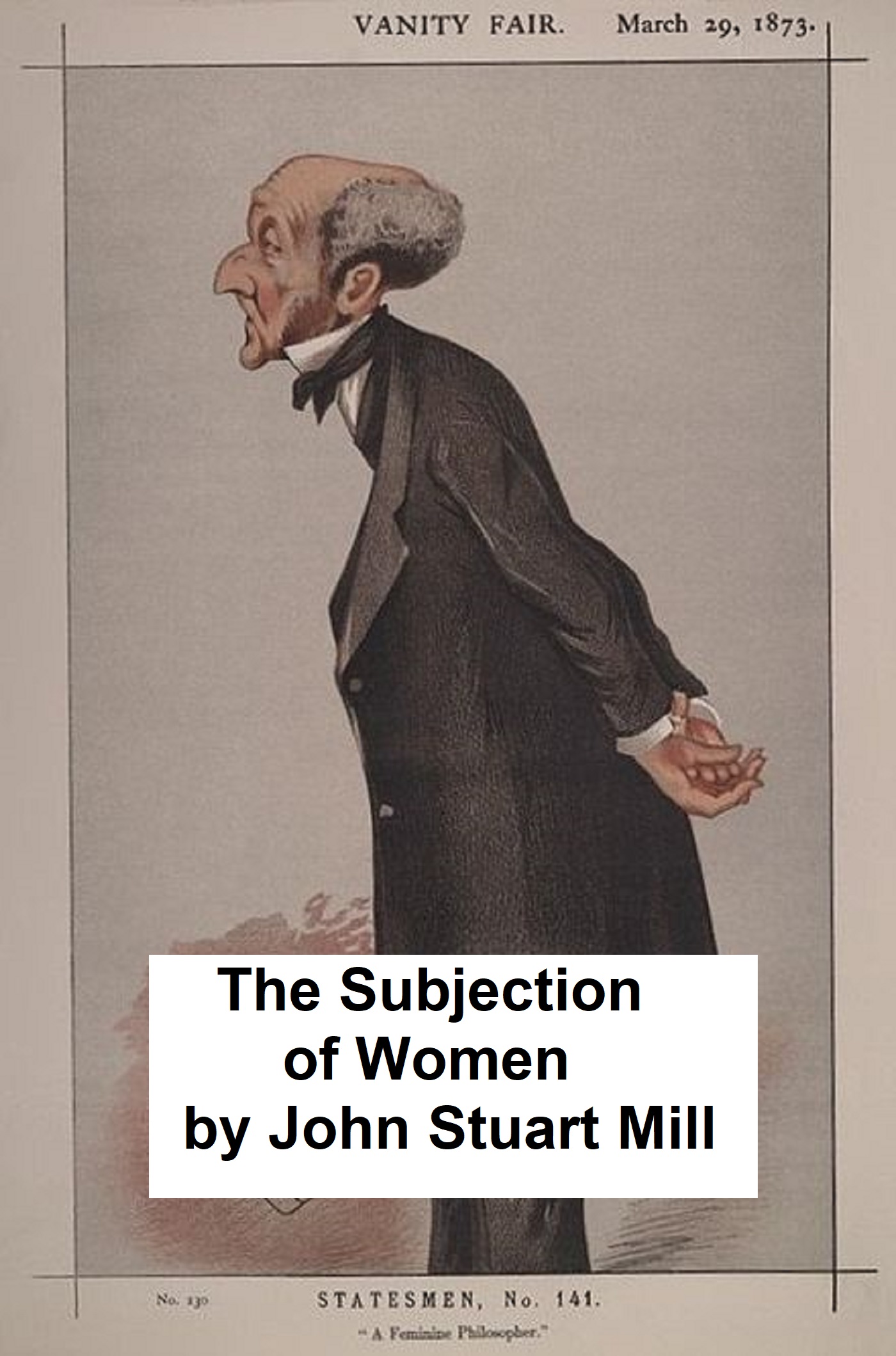 The
Subjection of Women by John Stuart Mill
The
Subjection of Women by John Stuart MillAccording to Wikipedia: "The Subjection of Women is the title of an essay written by John Stuart Mill in 1869, possibly jointly with his wife Harriet Taylor Mill, stating an argument in favour of equality between the sexes. At the time it was published in 1869, this essay was an affront to European conventional norms for the status of men and women."
99 cents at Kobo
 The Four Epochs of Woman's Life, a study in
hygiene (c. 1900) by Anna M. Galbraith
The Four Epochs of Woman's Life, a study in
hygiene (c. 1900) by Anna M. GalbraithVintage women's health book, first published around 1920. Dated information, of interest for historical reasons. "Perfect health is essential to perfect happiness. The greater the knowledge of the laws of nature, and the more closely these laws are lived up to, so much nearer "ideal" will be the health and happiness of the individual. Hence the necessity that these same laws should be as familiar to the adult man and woman as the alphabet. Further, with our present knowledge of the certain suffering, disease, and death that are bred by ignorance of all these subjects, it is little less than criminal to allow girls to reach the age of puberty without the slightest knowledge of the menstrual function; young women to be married in total ignorance of the ethics of married life; women to become mothers without any conception of the duties of motherhood; other women, as the time approaches, to live in dread apprehension of "the change of life;" and many women unnecessarily to succumb to disease at this time."
99 cents at Kobo
99 cents at Nook (Barnes and Noble)
 Great Women
by John Lord
Great Women
by John LordChapters include: Heloise - Love, Joan of Arc - Heroic Women, Saint Theresa - Religious Enthusiasm, Madame de Maintenon - The Political Woman, Sarah, Duchess of Marlborough - The Woman of the World, Madame Recamier - The Woman of Society, Madame de Stael - Woman in Literature, Hannah More - Education of Woman, and George Eliot - Woman as Novelist.
99 cents at Kobo
99 cents at Nook (Barnes and Noble)
 The
Women of Tomorrow, Illustrated, by William Hard
The
Women of Tomorrow, Illustrated, by William HardFirst published in 1911. The author explains: "The woman of to-morrow will not differ from the woman of yesterday in femininity or physique or capacity, in her charm for men, or her love of children, but in the response of her eternally feminine nature to a changed environment. The environment is bound to alter the superficial characteristics of woman as every change has done. Man, in his turn, will be a beneficiary of this new womanliness as he has been the ready victim of the old-womanishness".
99 cents at Kobo
99 cents at Nook (Barnes and Noble)
seltzer@seltzerbooks.com privacy statement